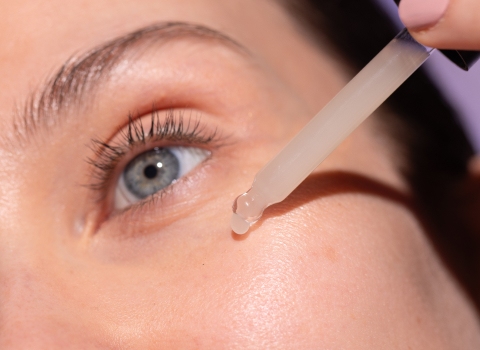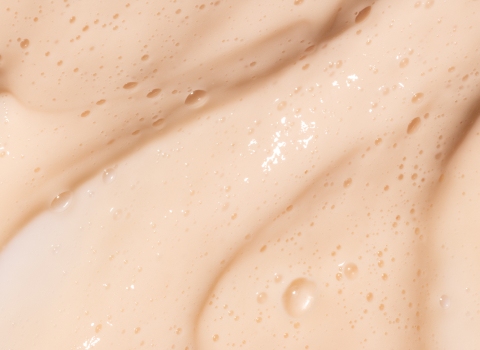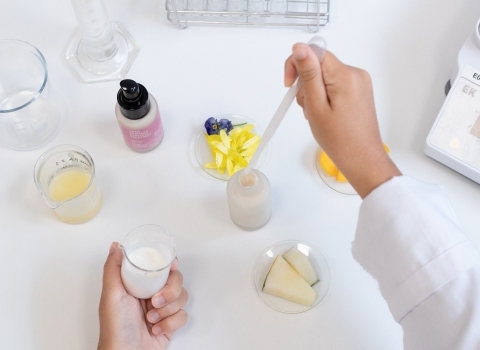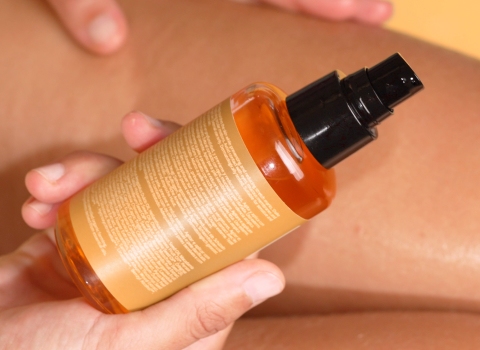Silicones, sulfates, parabens… 11 synthetic compounds and their alternatives in natural cosmetics

More and more people are looking for "toxic-free cosmetics" to take care of their skin and hair. Is that your case? Before we begin, it's important to know that all products on the market comply with strict regulations, so they are free from any substance considered toxic.
However, it is true that some synthetic ingredients spark debate due to their impact on the skin, hair, and the environment: silicones, sulfates, parabens, phthalates, paraffins, alcohol, plastic particles... Do they sound familiar? Let’s talk about them!

Silicones, sulfates, parabens… What are they and why don’t we use them at Freshly?
SILICONES AND MINERAL OILS
These are direct derivatives of petroleum and silicon, providing a silky and smooth sensation. They are not harmful per se, but they only provide a temporary effect since they do not contain nutrients that improve the health of the skin or hair. This can create a certain dependency. What would be a good alternative? For example, plant oils, which prevent dehydration and, in addition, provide fatty acids and vitamins that offer long-term benefits.
*How to recognize silicones and mineral oils:
They appear in the INCI as: Paraffinum, Paraffinum Liquidum, Petrolatum. Also, all ingredients ending in -cone, -siloxane, and -conol, such as: Dimethicone, Cyclomethicone, or Cyclohesasiloxane.
SULFATES
Sulfates are used as surfactants in shampoos, gels, or toothpaste and are responsible for creating large, dense foam. But therein lies the problem, as they are aggressive to the skin, stripping it of any lipids it may have, leading to irritation and microbiota imbalances. Additionally, they are usually formulated with a more alkaline pH, which also contributes to irritation, making the hair more fragile and brittle. Nowadays, very few shampoos and gels do not contain sulfates, as they are much cheaper than natural substitutes like glucosides.
*How to recognize sulfates:
They appear in the INCI with the word: sulfate. Some examples include the well-known Sodium Lauryl Sulfate (SLS) and Sodium Laureth Sulfate (SLES), but there are also others like Coco Sulfate or Ammonium Laureth Sulfate.
PARABENS
Parabens are a type of preservative widely used in the cosmetics industry for their ability to prevent the growth of microorganisms. Scientific studies have shown that some types of parabens (not all) can interfere with the endocrine system. In fact, some have already been banned. Therefore, at Freshly, we prefer to avoid using them and instead choose natural preservatives that are equally effective and more respectful.
*How to recognize parabens:
They appear in the INCI with the suffix: -paraben. For example: Methylparaben, Propylparaben, Butylparaben, Ethylparaben.
ALUMINUM SALTS
Aluminum salts are commonly used in deodorants and antiperspirants. Some research suggests that aluminum may act as an endocrine disruptor because it prevents perspiration and sweat from leaving the skin (it is an antiperspirant). Natural deodorants, however, are an effective and more respectful alternative.
In the case of Freshly, the formula allows for natural perspiration, inhibits the bacteria that cause odor, and absorbs sweat.
*How to recognize aluminum salts:
They are found in various products in the form of Aluminum Chlorohydrate.

PHTHALATES
Phthalates are plastic substances with multiple uses, commonly added to many perfumes and cosmetics in the conventional industry to fix scents. Most of them are banned in cosmetics. In the case of diethyl phthalate (DEP), there is a scientific debate, and studies are being conducted to determine its role as an endocrine disruptor. At Freshly, we choose natural and safe alternatives.
*How to recognize phthalates:
Fortunately, they are now banned in the cosmetic industry, so you won’t find them in the INCI.
PHENOXYETHANOL
Often used as a substitute for parabens, and although it does not interfere with the endocrine system, its use also generates controversy as some laboratory studies have linked it to skin irritation or sensitivity in some individuals, especially with continuous exposure or in high concentrations. However, the risk of sensitization is low and mainly associated with sensitive skin.
*How to recognize phenoxyethanol:
It appears in the INCI as: Phenoxyethanol.
FORMALDEHYDE RELEASE AGENTS
Formaldehyde is one of the most controversial ingredients. In 2004, the WHO included it in the list of carcinogenic substances, and exposure to it can cause allergies, irritation, premature skin aging, and even damage to cell membranes. Therefore, its use in cosmetics is banned. However, ingredients that release formaldehyde when combined are allowed in formulas. Final products with formaldehyde-releasing agents must label “contains formaldehyde” when it exceeds 0.05%.
*How to recognize formaldehyde-releasing agents:
All compounds that are named with a word that accompanies urea, for example: Diazolidinyl urea. However, it is important to note that the word "urea" alone poses no risk. Also, substances accompanied by the letters DM, like DM hydantoin.
Also, compounds such as: Dimethyl Oxazolidinone, Amyl Acetate, Alkylphenol, or all compounds including the term Quaternium.
SYNTHETIC FRAGRANCES OR PERFUMES
This is a large family of compounds used to give a characteristic scent to cosmetic products, and although not all, some are associated with an increase in allergies and skin reactions. At Freshly, we work with naturally sourced ingredients to create our fragrances, such as essential oils, which provide unique aromas and offer benefits related to well-being: relaxation, mood improvement… Additionally, they provide antioxidants. The best part of these natural fragrances is that they have a richer and more sustainable composition than synthetic ones.
*How to recognize synthetic fragrances or perfumes:
They appear in the ingredient list as Parfum or Fragance.
Only those that specify “Natural ingredients derived from essential oils” are trustworthy. At Freshly, all our perfumes are 100% certified natural, including only a combination of natural essential oils.
SYNTHETIC COLORANTS
As the name indicates, they are responsible for the color in many cosmetic formulas. They are derived from petrochemical compounds. Some synthetic colorants can be legally used without risk as long as purity, concentration, and usage conditions are respected, but in general, they are linked to a higher likelihood of allergies and reactions. At Freshly, we prefer to use natural colorants, even though they are more expensive and less durable.
*How to recognize synthetic colorants:
You’ll detect them because they include the syllables –anilin- or –anilid– (e.g., Acetanilid). Or simpler formulas like: HC (HC orange 3), Acid (Acid red 73), Pigment (Pigment green 7).
POLYETHYLENE GLYCOL COMPOUNDS (PEG’S)
This compound is not very beneficial for skin health because it deteriorates the skin’s barrier function, leaving it exposed to the penetration of other compounds and toxins. They are often solubilizers to mix oily ingredients with water, but they make the dermis more permeable. Additionally, the use of PEGs involves an energy-intensive production process that is highly polluting, and it is a type of compound that does not biodegrade.
*How to recognize PEG’s:
PEG followed by a number (e.g., PEG 14). Also by the letters –eth at the end, such as Steareth.
POLYCYCLIC COMPOUNDS
These are also used to add fragrance to products. From an environmental and human health perspective, the use of polycyclic compounds in cosmetics is controversial due to their environmental persistence, bioaccumulation, and potential to act as endocrine disruptors. While they have not been completely banned, their regulation is under review, so we prefer to avoid them (especially recommended during pregnancy and breastfeeding).
*How to recognize polycyclic compounds:
You’ll recognize them by terms like Galaxolide (HHCD) or Tonalide (AHTN).
THE KEY IS IN THE INCI
To avoid these substances, it is essential to check the INCI, i.e., the ingredient list of your cosmetics, and see if these terms appear.
The good news is that there are more respectful natural alternatives for the skin, hair, and that also have no direct impact on the environment. Want to know more?

The natural alternative for sensitive skin
At Freshly, we only use ingredients that, in addition to being effective in improving skin issues, are safe, gentle, and biocompatible. This means that your skin and hair cells recognize and absorb them easily, which improves the user experience and reduces the risk of adverse effects. To achieve this, we restrict the ingredients listed above... and more than 1,000 other ingredients!
Instead, we formulate cosmetics that are over 99% natural, clinically effective, dermatologist-tested, without adverse effects, and biocompatible.
We strive to create effective cosmetic formulas with safe ingredients that your skin easily recognizes and integrates, offering real value to your body. But not only that, these formulas are also vegan, planet-friendly, and above all, free from...
FREE FROM ingredients that could interfere with the natural functions of our body or could be harmful or irritating to your skin and health. That’s why our formulas are...
- FREE FROM parabens, sulfates, silicones, phenoxyethanol, phthalates (DBP, BBP, DEHP, DEP), triclosan and triclocarban, BHT, tar, 1,4-dioxane, formaldehyde and formaldehyde-releasing agents, fluoride, lead, and lead acetate.
- FREE FROM chemical filters (Homosalate, Octocrylene, Octinoxate (Octinoxate, Ethylhexyl methoxycinnamate), 4-Methylbenzylidene camphor, Octisalate (octisalate, ethylhexyl salicylate), PABA (para-aminobenzoic acid), Padimate O (Ethylhexyl dimethyl PABA), Ethylhexyl triazone (octyl triazone), Benzophenone, Oxybenzone, Ensulizole (phenylbenzimidazole sulfonic acid)), synthetic perfumes (hydrocarbons, alcohols, aldehydes, ketones, aliphatic and aromatic esters), polyethylene glycol (PEG) compounds, synthetic colorants, aluminum salts, chelating agents (EDTA, DTPA, HEDTA), nano raw materials.
FREE FROM ingredients that could damage the planet, such as...
Phthalates (DBP, BBP, DEHP, DEP), triclosan and triclocarban, silicones, plastics, plastic exfoliating particles, bisphenols, glitter, Ensulizole (phenylbenzimidazole sulfonic acid), polyethylene glycol (PEG) compounds, tar, chelating agents (EDTA, DTPA, HEDTA), nano raw materials.
Mineral oils (Petrolatum, Paraffin, Paraffinum Liquidum, C10-11 Isoparaffin, Isododecane, Isohexadecane, Hydrogenated Polyisobutene, Synthetic Wax, Ceresin, Ozokerite), chemical sunscreen filters.
FREE FROM animal-derived ingredients...
Without animal derivatives (shark squalene, keratin, pig collagen, bovine elastin, sebum, chicken/bovine hyaluronic acid, honey and beeswax, lanolin...).

Our Commitment: Natural Cosmetics Without Adverse Effects
To ensure that our formulas exclude all these ingredients while being innovative, effective cosmetics that offer real value to the body and are respectful to both the skin and the planet, we have the Freshly Lab, an innovation center where a team of experts works to respond to the latest trends and needs in the cosmetic market:
- We listen to our customers: We begin our process by capturing every need and desire to create products that truly meet your expectations.
- We innovate in the Freshly Lab: Our team of experts transforms those ideas into innovative formulas, using carefully selected ingredients to ensure maximum efficacy and safety.
- We design our packaging: We choose each container with functionality and the future of the planet in mind, opting for sustainable materials and responsible designs that minimize environmental impact.
- Tested Efficacy: We conduct thorough dermatological and clinical tests on different skin types, including sensitive and reactive skin, ensuring that every product is safe and respectful.
Now you know why at Freshly we restrict over 1,000 ingredients. And most importantly, you understand the reality of the synthetic compounds currently in use, how to identify them, and what natural alternatives exist, so you can choose your products freely
Freshly wants to tell you something! At Freshly we keep on learning every day how to make decisions that bring us closer to a better future. Sometimes we are called dreamers, but what we really have is an optimistic vision and clear path for reaching that tomorrow.
Would you like to join this adventure? If you're here, it's because you are a demanding person when it comes to taking care of your body and the planet. By subscribing to the newsletteryou will receive articles like this one to continue learning, as well as news and exclusive discounts. Are you up for it?
